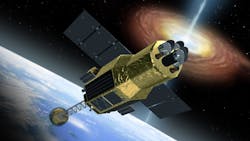Air Force chooses Honeywell to design radiation-hardened gyroscope for satellite attitude reference in space
KIRTLAND AIR FORCE BASE, N.M. – U.S. Air Force space warfare experts needed a small, lightweight navigational gyroscope for spacecraft applications able to withstand the effects of enemy nuclear explosions. They found their solution from Honeywell Aerospace in Phoenix.
Officials of the Air Force Research Laboratory's Space Vehicles Directorate at Kirtland Air Force Base, N.M., announced a $41.6 million contract to Honeywell on Wednesday to design the Compact Strategic-Grade Gyroscope (CSG).
This project seeks to design gyroscope technology capable of performing in space and strategic environments, with an eventual path to operating through radiation and electromagnetic pulse of nuclear explosions.
The gyro will have high accuracy and minimal degradation over a typical strategic systems service lifetime, and show a technology path to hostile radiation tolerance.
The five-year CSG project has five objectives: build and test four prototypes; make iterative improvements to design six strategic-grade units; continue with improvements that will include developing a radiation-hardened application-specific integrated circuit (ASIC) and VHDL software code; integration into experimental space vehicles for a one-year mission at low-Earth orbit; and develop a radiation-hardened gyroscope as an attitude reference system aboard a space vehicle.
The initial four prototypes will be 30 cubic inches in size, with an eventual goal of 15 cubic inches. The final prototypes that will perform as spacecraft attitude reference systems will be about 65 cubic inches in size.
On this contract Honeywell will do the work in Phoenix, and should be finished by August 2025. For more information contact Honeywell Aerospace online at https://aerospace.honeywell.com, or the Air Force Research Lab Space Vehicles Directorate at https://www.kirtland.af.mil/Units/AFRL-Space-Vehicles-Directorate.

John Keller | Editor-in-Chief
John Keller is the Editor-in-Chief, Military & Aerospace Electronics Magazine--provides extensive coverage and analysis of enabling electronics and optoelectronic technologies in military, space and commercial aviation applications. John has been a member of the Military & Aerospace Electronics staff since 1989 and chief editor since 1995.

